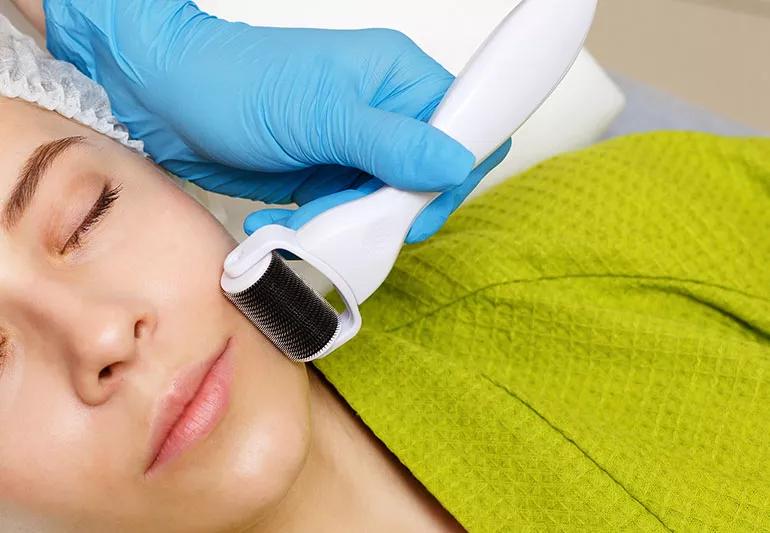Advertisement
Weigh the benefits, risks & costs

You’ve probably seen the Instagram ads for microneedling. They promise youthful and rejuvenated skin. But can hundreds of tiny needle pricks actually make your skin look better?
Advertisement
Cleveland Clinic is a non-profit academic medical center. Advertising on our site helps support our mission. We do not endorse non-Cleveland Clinic products or services. Policy
The short answer is yes. It can offer benefits if you’re looking to refresh your skin. The procedure helps treat damage from sun exposure, tightens wrinkles and can make acne scars less noticeable.
Dermatologist Amy Kassouf, MD, answers six questions on what you should know about this popular cosmetic treatment.
A: Also known as collagen induction therapy, microneedling involves either a fine-needle roller or pen device that creates tiny holes in the top layer of the skin. An application of skin cream or serum is often added after the procedure.
This “controlled injury” process opens up your skin with tiny tears. Then, healing promotes collagen production, which helps fill in and smooth out wrinkles and fine lines, Dr. Kassouf says.
A: In addition to treating wrinkled and sun-damaged skin, microneedling can improve scars from acne and other abnormalities. It’s most commonly used on the face. But dermatologists may also use it on other parts of the body — to smooth out thighs or stomach stretch marks, for instance.
It can help rejuvenate your skin, but Dr. Kassouf always cautions her patients: If you have damaged skin, no procedure can make it look perfect again.
A: Minor pain. A topical numbing agent helps control the “pokey” sensation you might feel during the procedure. But some patients may experience minor pain afterward and the skin may remain red for a few days.
Advertisement
Infection. Though the needle holes are tiny, they are open wounds and can become irritated or infected. You’ll need to keep the skin clean and avoid irritating lotions, swimming pools, gyms and other possible exposure to infection. “I’ve only seen one infection,” Dr. Kassouf says.
Skin discoloration. Some light or dark discoloration may occur, especially for people of color. But it’s usually temporary, she says.
“More attention is now being paid to what you apply to the skin after the procedure,” explains Dr. Kassouf. “Microneedling disrupts the skin barrier function, allowing both helpful and potential harmful molecules beneath the surface. Using an anti-oxidant containing topical can augment results after microneedling, but it’s also important to avoid harsh topicals and environments that are dirty or polluted.”
A: Microneedling is an elective cosmetic procedure, so insurance will not cover any of the cost. Typically, a person needs four to six treatments for the best outcome, Dr. Kassouf says.
Your doctor will determine how many treatments you’ll need and estimate their cost.
A: “I have not personally worked with them,” Dr. Kassouf says. “They are less aggressive, but you might get some minor benefits.”
If you use a home kit, the key is to make sure the instruments you use are clean.
She says some patients who have used a kit tell her they were not satisfied with the results. She has had several who sought a professionally administered procedure after using a home kit.
A: While the treatment is often beneficial, dermatologists generally agree that more expensive laser resurfacing will produce better results. However, doctors consider microneedling as a more affordable alternative to fractional laser treatments, Dr. Kassouf says.
Fractional laser treatments use thermal energy to produce the tiny skin tears that stimulate collagen production. They improve fine lines, skin texture and color and may also remove a layer of dead skin to expose fresher, healthier-looking skin.
They cost about four times as much as microneedling treatments. Most patients need three to five laser treatments for optimal results.
A newer form of microneedling is also available that adds radiofrequency energy to the needles. The energy creates heat that enhances the collagen contraction and micro wounding to help improve the final results. There is more downtime with this procedure and potentially more risk of discoloration and scarring, but overall it’s considered safe. It’s typically more expensive, so make sure you speak with your dermatologist about what treatment is right for you.
Advertisement
Dr. Kassouf offers a few final tips:
Advertisement
Learn more about our editorial process.
Advertisement

Using precautions like bandages and lubricants can help you run away from this uncomfortable condition

Laser hair removal, laser surgery, excision and steroid injections are all potential treatment options

Use products that reduce inflammation without causing irritation and avoid fragrances, dyes and exfoliators

Nutrition plays an important role in managing this chronic inflammatory skin disease

These oats can help soothe dry skin and mild rashes and may help improve your skin’s microbiome

Botox isn’t your best choice during pregnancy — try topical vitamin C and moisturizers in the meantime

Aloe vera, warm compresses and diet adjustments can help alleviate symptoms

Popping or prodding at these cysts could lead to infection

If you’re feeling short of breath, sleep can be tough — propping yourself up or sleeping on your side may help

If you fear the unknown or find yourself needing reassurance often, you may identify with this attachment style

If you’re looking to boost your gut health, it’s better to get fiber from whole foods